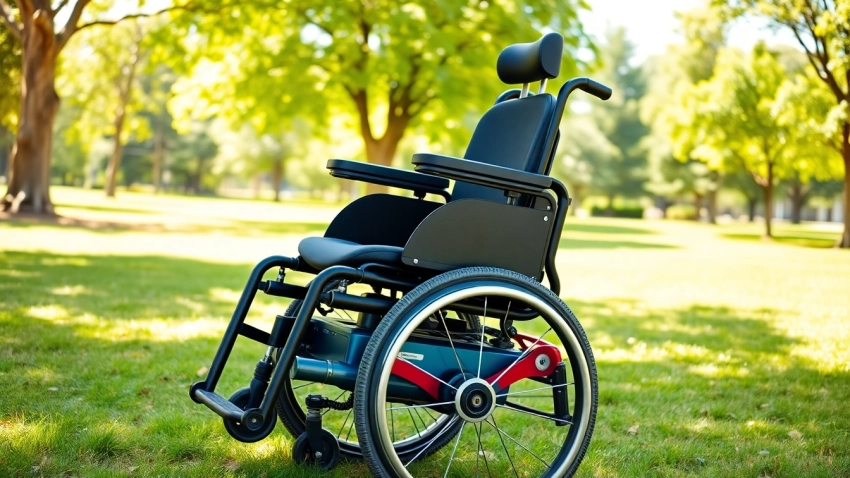
Enhance Mobility: The Benefits and Features of Electric Wheelchairs
Understanding Electric Wheelchairs
What is an Electric Wheelchair?
An Electric Wheelchair, often referred to as a power wheelchair, is a mobility device that provides transport for individuals with limited mobility. Unlike traditional manual wheelchairs, these chairs are powered by batteries and equipped with a motor, enabling users to navigate independently without the need for physical propulsion. With their growing popularity, Electric wheelchairs have become vital tools for enhancing the independence of individuals with varying degrees of mobility challenges, allowing them to participate more actively in daily activities.
Key Components and Features
Electric wheelchairs are built with several integral components that contribute to their functionality and user experience. Understanding these components is crucial for selecting the right model. Essential parts include:
- Chassis: The frame that supports the entire structure of the wheelchair and ensures stability.
- Batteries: Power the wheelchair, allowing for mobility over long distances. Most electric wheelchairs use rechargeable batteries that vary in capacity and operational time.
- Motor: This propels the wheelchair forward and backward, controlled usually by a joystick or control panel.
- Seating System: Often includes cushions designed for comfort and posture support, these seats can sometimes be tailored to fit the user’s needs.
- Wheels and Tires: Varying designs for different terrains; users can choose standard wheels for smooth surfaces or larger wheels for outdoor navigation.
Moreover, many modern electric wheelchairs come equipped with advanced features such as adjustable armrests, reclining backs, and even tilt functions to enhance user comfort and convenience.
Types of Electric Wheelchairs Available
Electric wheelchairs come in various types, each tailored to specific needs and environments. Here’s a breakdown of some common types:
- Foldable Electric Wheelchairs: Easy to transport and store, these models are perfect for individuals who travel frequently.
- Heavy-Duty Electric Wheelchairs: Designed for individuals requiring higher weight capacities or those who navigate rough terrain. These models often provide additional stability and durability.
- Lightweight Electric Wheelchairs: Offer portability without sacrificing too much in performance, making them ideal for indoor use.
- Standing Electric Wheelchairs: Allow users to shift from a seated to a standing position, promoting better circulation and reducing the risk of pressure sores.
Understanding the available types will significantly assist potential buyers in making an informed decision tailored to their specific needs. Factors such as lifestyle, weight requirements, and intended environment should inform the choice.
Benefits of Using Electric Wheelchairs
Improved Mobility and Independence
One of the most pronounced benefits of electric wheelchairs is the enhanced mobility they provide. Users can easily navigate their homes, workplaces, and communities without assistance, which greatly improves their quality of life. This increased independence helps reduce reliance on caregivers, allowing users to manage daily tasks, like grocery shopping or attending social events, more easily.
Health Advantages of Electric Wheelchairs
Utilizing an electric wheelchair can also yield several health benefits. Users often experience:
- Reduced Physical Strain: Unlike manual wheelchairs, where upper body strength is essential for propulsion, electric wheelchairs require minimal physical exertion.
- Enhanced Posture Support: Many models offer adjustable features that promote better posture, potentially alleviating back pain.
- Increased Physical Activity: Independence gained through electric wheelchairs encourages users to be more active socially and physically, contributing to overall well-being.
Recognizing that mobility aids can also enhance health is critical for both users and caregivers in the decision-making process.
Enhanced Comfort Features Compared to Manual Options
Electric wheelchairs typically incorporate advanced ergonomic designs and comfort features that are often superior to manual wheelchairs. For instance:
- Adjustable Seating: Users can customize their seating position, which helps in preventing pressure sores and ensuring comfort for extended use.
- Shock Absorption: High-end models feature enhanced shock absorption mechanisms, making ride quality smoother over uneven surfaces.
- Additional Accessories: Features such as gel cushions, lumbar support, and heated seats are often available, enhancing the overall comfort level.
This attention to user comfort not only contributes to their physical well-being but also enhances emotional satisfaction while using these devices.
Choosing the Right Electric Wheelchair
Factors to Consider Before Purchase
Selecting the right electric wheelchair involves several key considerations. Prospective users should evaluate the following factors:
- Weight Capacity: Ensure the model supports the user’s weight adequately.
- Range: The distance a charge will allow the wheelchair to move is crucial, particularly for users who need to travel longer distances.
- Terrain Types: Determine where the wheelchair will be primarily used. Indoor models may differ significantly from those designed for outdoor use.
- Size and Dimensions: Consider the dimensions for fitting through doorways and fit in home spaces.
- Control Mechanisms: Look for models with intuitive controls that suit the user’s abilities. Joystick options, for example, vary significantly in sensitivity and ergonomics.
Understanding these factors ensures that the electric wheelchair meets both current and future needs efficiently.
Top Brands and Models of Electric Wheelchairs
While there are numerous brands available in the market, some stand out due to their reliability and innovative features. Some of the leading brands include:
- Pride Mobility: Known for a wide range of models catering to different needs, including outdoor mobility.
- Sunrise Medical: Offers high-quality options with advanced ergonomic designs.
- Permobil: Frequently praised for their cutting-edge technology and premium comfort features.
- Invacare: Reliable options that often appeal to various users due to their versatility.
Researching specific models within these brands can reveal the variety of features and price points available, helping users choose the best fit.
Personalization Options for Your Electric Wheelchair
Many electric wheelchairs allow for a significant level of personalization. Adjustments can be made concerning:
- Cushioning and Comfort Features: From seat width to backrest angles, users can choose configurations that best suit their body type.
- Color and Design: Aesthetic customization options enable users to express their individuality.
- Accessories: Accessories like cup holders, storage bags, or mobile device holders can often be added to enhance functionality.
Personalization enhances the user’s comfort and satisfaction, fostering a more enjoyable experience overall.
Maintaining Your Electric Wheelchair
Routine Checks and Maintenance Tips
Regular maintenance is essential for ensuring the longevity and performance of an electric wheelchair. Here are some routine checks and tips:
- Batteries: Regularly check battery levels and connections, clean terminals to prevent corrosion, and follow recharging guidelines to prolong battery life.
- Wheels and Tires: Inspect for wear and tear, ensuring that they are adequately inflated (if applicable) and free from debris that could affect mobility.
- Electrical Components: Periodically assess the joystick or control panel functionality. Any signs of malfunctions should be addressed immediately.
- Cleaning: Regularly clean the wheelchair, focusing on the frame, wheels, and seating areas to maintain hygiene.
Adhering to a maintenance schedule prevents minor issues from developing into significant problems, safeguarding the user’s investment.
Common Issues and Troubleshooting
Despite proper maintenance, electric wheelchairs can still present challenges. Recognizing common issues and their solutions is important:
- Battery Not Charging: Ensure the charger is connected and functioning. If the battery is old, it may need replacement.
- Joystick Not Responding: This could result from electrical connection issues or dust accumulation. A thorough cleaning may help.
- Slow Speed: Check the battery and motor connections, as poor power can affect speed.
Consulting the user manual often yields additional troubleshooting tips and guides specific to the model.
When to Consult a Professional Service
Even with diligent care, some situations necessitate professional intervention, including:
- Severe Damage: Cracks in the frame or broken components require immediate professional repair.
- Mysterious Electrical Issues: If the wheelchair exhibits erratic behavior, it’s advisable to consult an expert, as they can diagnose hidden problems.
- Frequent Battery Drain: A sudden drop in performance might indicate a battery issue requiring testing or replacement.
Staying proactive in communication with specialists ensures both optimal performance and safety.
Personal Stories and User Experiences
Real-Life Testimonials of Electric Wheelchair Users
User experiences provide valuable insights into the practical benefits and challenges encountered with electric wheelchairs. Consider the following testimonials:
“My electric wheelchair has completely changed my life. I can go out on my own, visit friends, and even join in community events – something I never thought was possible!” – Sarah, 34
“Transitioning to an electric wheelchair was daunting at first, but it gave me the independence I desperately needed. I can now navigate my house and community without a worry.” – John, 45
These testimonials illustrate that while the benefits can be significant, the adjustments to using a motorized device also require personal adaptation.
Challenges Faced by First-Time Users
First-time users often encounter various challenges, such as:
- Learning Curve: Operating a joystick may take practice, leading to occasional mishaps or lack of confidence.
- Space Constraints: Adjusting to navigating through tight spaces or narrow doorways can be challenging.
- Battery Management: New users may initially struggle with understanding battery life and charging routines.
It’s crucial for manufacturers and retailers to provide comprehensive training and resources for new users to help them acclimate to their new mobility aids smoothly.
Advice from Long-Term Electric Wheelchair Users
Long-term users often share invaluable advice based on their experiences, such as:
- Invest in Quality: A well-built electric wheelchair may be more expensive but pays off in durability and comfort.
- Routine Checks Matter: Regular checks and maintenance can make a significant difference in performance and reliability.
- Stay Engaged: Participate in user groups or forums to share experiences and gain insights from others in similar situations.
This wealth of shared knowledge helps new users navigate challenges with confidence and encourages them to maximize the benefits of their electric wheelchairs.












Leave a Reply